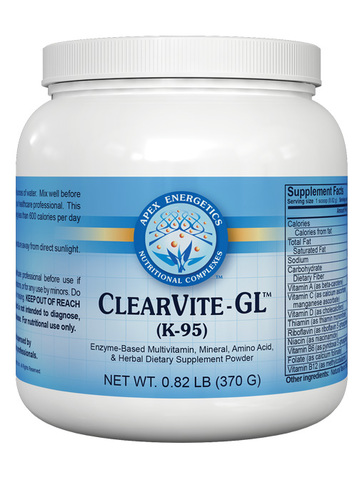
Product Description:
ClearVite-GL™ (K95) is based on on our popular ClearVite™ formula and is designed to offer gastrointestinal and metabolic support.* This formula...

The prostate gland and male reproductive system are predominantly affected. If the cancer metastasizes, it can spread to other organs in the body through the lymphatic system. Only a small percentage of migrating cancer cells can actually produce a tumor. However, if successful, it becomes Metastatic Prostate Cancer, and cure rates considerably decline (“About Prostate Cancer”, 2010).
Almost 100% of all men will develop and harbor cancerous cells in their prostate if they live long enough, so age becomes a risk factor. Most tumors are very slow growing and rarely become life threatening. African-American men and men with relatives who have had prostate cancer are at a relatively higher risk. Other risk factors include obesity, smoking, high-fat diet and occupational exposure (Rakel, 2007, p. 848 - 850). Vitamin D deficiency and essential fatty acid deficiency (especially omega-3) may contribute to prostate cancer (“Vitamin D and Prostate Cancer”, 2006; Bland, 2004, p. 73). Xenobiotics (toxins) like herbicides and pesticides, as well as endocrine disruptors like PCBs in plastic may increase cancer risk by causing DNA damage (Rakel, 2007, p. 852).
Screening for prostate cancer is done using blood tests to measure prostate-specific antigen (PSA) with digital rectal examinations (DRE) and a urinary symptom questionnaire. Starting at age 50 or earlier if there is familial history of the disease, men are encouraged to take annual prostate screening (Rakel, 2007, p. 850). If prostate cancer is suspected, then a tissue biopsy of the gland using ultrasound imagery will be used to diagnose malignancy (“About Prostate Cancer”, 2010).
Biomedical Approach
Typical treatments include surgery to remove tumors and radiation for advanced or recurrent cancers. Since prostate cancer is typically very slow growing, removal of growths tend to be very effective. Hormone therapy and chemo therapy may also be used. (“About Prostate Cancer”, 2010; Rakel, 2007, p. 850). The pharmaceutical drug Celebrex is known to dramatically reduce PSA doubling times and is often used in treatment (Rakel, 2007, p. 854).
Botanicals and Herbs
Catechins found in green tea is believed to prevent prostate cancer. Green tea’s benefits are dose related. The recommendation for prostate cancer prevention is 3 to 5 cups of decaffeinated green tea daily, or 500 mg of green tea extract daily. If cancer is present, green tea extract twice daily is recommended (Rakel, 2007, p. 854).
Nutritional Approach
Excessive calorie intake and saturated fat encourage obesity and prostate cell growth by increasing production of IGF-I and inflammatory arachidonic acid (AA) byproducts. Omega-6 fatty acids like those in corn oil stimulate tumor growth, while omega-3 and omega-9 fatty acids have the opposite effect. By avoiding foods that increase AA production like animal fats, hydrogenated oils and dairy products, men can reduce their prostate cancer risk (Rakel, 2007, p. 852-853).
Diets high in fruits, vegetables especially cruciferous vegetables, may decrease risk of prostate cancer. A plant-based diet appears to slow the PSA doubling rate (Rakel, 2007, p. 853).
Some studies of Japanese and American men suggest that isoflavones found in soy protein inhibit prostate cancer cell growth. Some practitioners suggest men should drink soy milk and consume 4 oz. of soy protein daily for prevention. The cancer-fighting antioxidant lycopene helps protect against prostate cancer. 4 servings of cooked tomato products a week, 10 servings per week if already diagnosed, are recommended (Rakel, 2007, p. 853).
Ground flaxseed appears to be highly effective in preventing prostate cancer, and assisting in the treatment of diagnosed patients. Lignans in flaxseed bind to male hormone receptors and promote the elimination of testosterone (Murray, 2005, p. 427).
Consider Nutritional Supplementation: Vitamin E, Selenium, Zinc, Lycopene (Rakel, 2007, p. 853-854; Murray 2005, p. 427).
Avoid smoking and excessive alcohol consumption. The heavy metal cadmium found in tobacco may increase the risk of prostate cancer. Though moderate consumption of red wine may be good in prevention of prostate cancer, indiscriminate consumption of alcohol should be avoided. Hormone-altering medications and supplements like DHEA and the popular supplement chondroitin sulfate should be avoided. Studies suggest these may spread prostate cancer. Produce should be organic if possible, or properly washed to eliminate the presence of xenobiotics. Exercise for at least 30 minutes a day, three times a week, is highly suggested. (Rakel, 2007, p. 851-852)
There is conflicting information about the use of soy products and their health benefits. Though studies show health benefits in populations that eat substantial amounts of soy protein, these soy foods have been typically fermented soy products, like tempeh and miso. Products like soy milk and highly refined soy foods like soy dogs were not part of these culture’s diets. It may be better recommended that fermented soy products, especially miso (which appears to have proven benefits in preventing prostate cancer), should be included in the diet rather than soy milk. Most soy is also known to be genetically modified and its safety has yet to be proven (“Soy Alert!”, 2010). A life-long commitment to a whole-food, organic, mostly plant based diet appears to ward off this potentially life-threatening form of cancer. A move by the American culture to this sort of lifestyle can only encourage a decrease in the incidence and prevalence of prostate cancer. Educating the male public to healthy eating habits is of primary concern and should be starting at an early age.
Resources
About Prostate Cancer, (2010), Retrieved from http://www.prostatecancerfoundation.org/site/c.itIWK2OSG/b.4983495/k.5C76/About_Prostate_Cancer.htm
Bland, J. et al, 2004, Clinical Nutrition: A Functional Approach, Gig Harbor, Washington: The Institute for Functional Medicine
Murray, M. 2005. The Encyclopedia of Healing Foods. New York: Atria Books.
Rakel, D. 2007. Integrative Medicine. Philadelphia, PA: Saunders
Vitamin D and Prostate Cancer, (2006), Retrieved from http://www.vitamindcouncil.org/cancerProstate.shtml

ClearVite-GL™ (K95) is based on on our popular ClearVite™ formula and is designed to offer gastrointestinal and metabolic support.* This formula...

Basic Foundation Program
By Art Presser, PharmD & Gene Bruno, MS, MHS – Huntington College of Health Sciences
Everyday our bodies make cancer. Everyday our bodies...